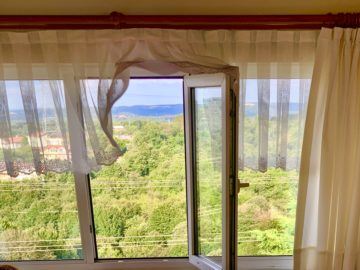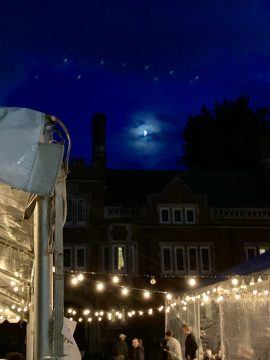by Shadab Zeest Hashmi
 Before I met Hayat Nur Artiran, I had only had a raw understanding of what female selfhood may look like, a notion I have been attempting to refine in my writings over many years. Here, at the Mevlevi Sufi lodge in Istanbul, I received a lifetime’s worth of illumination about the power of the spirit in the company of Nur Hanim, beloved Sufi Hodja and the President of the Sefik Can International Mevlana Education and Culture Foundation. A researcher, author and spiritual leader on the Sufi path known as the Mevlevi order (based on the teachings of Maulana Jalaluddin Muhammad Balkhi Rumi, known in the West simply as the poet Rumi), Nur Hanim’s accomplishments shine a light on an ethos that has transformed hearts for nearly a millennium. More instrumental than personal achievement in this case, is the Sufi substance and finesse that Nur Hanim has nurtured in the running of this Mevlevi lodge. Spending a day here, on my most recent visit to Istanbul, I came to experience what I had thought possible, based on my Muslim faith, but had never witnessed before: men and women coexisting, learning, working and serving in harmony, a place where one forgets the ceaseless tensions between genders, generations, ethnicity, or those caused by differences in religious beliefs or the self-worshipping individualism that has become the insignia of modernity. Read more »
Before I met Hayat Nur Artiran, I had only had a raw understanding of what female selfhood may look like, a notion I have been attempting to refine in my writings over many years. Here, at the Mevlevi Sufi lodge in Istanbul, I received a lifetime’s worth of illumination about the power of the spirit in the company of Nur Hanim, beloved Sufi Hodja and the President of the Sefik Can International Mevlana Education and Culture Foundation. A researcher, author and spiritual leader on the Sufi path known as the Mevlevi order (based on the teachings of Maulana Jalaluddin Muhammad Balkhi Rumi, known in the West simply as the poet Rumi), Nur Hanim’s accomplishments shine a light on an ethos that has transformed hearts for nearly a millennium. More instrumental than personal achievement in this case, is the Sufi substance and finesse that Nur Hanim has nurtured in the running of this Mevlevi lodge. Spending a day here, on my most recent visit to Istanbul, I came to experience what I had thought possible, based on my Muslim faith, but had never witnessed before: men and women coexisting, learning, working and serving in harmony, a place where one forgets the ceaseless tensions between genders, generations, ethnicity, or those caused by differences in religious beliefs or the self-worshipping individualism that has become the insignia of modernity. Read more »

 The language of light is compelling. The suggestions of light at daybreak are vastly different from twilight or starlight, the light of a firefly is not the same as that of embers or cat eyes, and light through a sapphire ring or a stained glass window is not the same as light through the red siren of an emergency vehicle or through rice-paper lanterns at a festival. It matters to writers if the image they are crafting of light is flickering or glowing, glaring or fading, shimmering or dappled. A writer friend once commented on light as a recurring motif in my poetry, and told me that I’d enjoy her son’s work as a light-artist for theater. The thought struck me that light in a theater has a great hypnotic, silent power; it commands and manipulates not only where the audience’s attention must be held or shifted, how much of the scene is to be revealed or concealed, but also negotiates the many emotive subtleties and changes of mood. The same goes for cinema, photography, and other visual arts. Light almost always accompanies meaning.
The language of light is compelling. The suggestions of light at daybreak are vastly different from twilight or starlight, the light of a firefly is not the same as that of embers or cat eyes, and light through a sapphire ring or a stained glass window is not the same as light through the red siren of an emergency vehicle or through rice-paper lanterns at a festival. It matters to writers if the image they are crafting of light is flickering or glowing, glaring or fading, shimmering or dappled. A writer friend once commented on light as a recurring motif in my poetry, and told me that I’d enjoy her son’s work as a light-artist for theater. The thought struck me that light in a theater has a great hypnotic, silent power; it commands and manipulates not only where the audience’s attention must be held or shifted, how much of the scene is to be revealed or concealed, but also negotiates the many emotive subtleties and changes of mood. The same goes for cinema, photography, and other visual arts. Light almost always accompanies meaning.